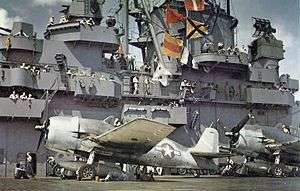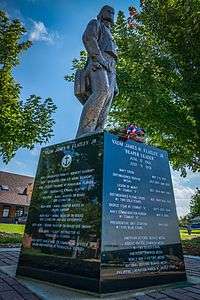James H. Flatley
| James Henry Flatley Jr. | |
|---|---|
 Then-Lieutenant Commander James H. "Jimmy" Flatley Jr. in 1942 in the cockpit of a Grumman F4F Wildcat fighter. | |
| Nickname(s) | Jimmy |
| Born |
June 17, 1906 Green Bay, Wisconsin |
| Died |
July 9, 1958 (aged 52) Bethesda, Maryland |
| Allegiance | United States of America |
| Service/branch | United States Navy |
| Years of service | 1929-1958 |
| Rank | Vice Admiral |
| Commands held |
Fighter Squadron 10 (VF-10) Carrier Air Wing 5 (CAW-5) USS Block Island (CVE-106) USS Lake Champlain (CV-39) |
| Battles/wars | |
| Awards |
Navy Cross Distinguished Flying Cross Bronze Star Navy Distinguished Service Medal Presidential Unit Citation |
Vice Admiral James Henry "Jimmy" Flatley Jr. (June 17, 1906 - July 9, 1958) was a World War II naval aviator and tactician for the United States Navy.
Early life
Flatley was born in Green Bay, Wisconsin, and graduated from St. Norbert College. He was a 1929 United States Naval Academy graduate who earned his wings in 1931. An early squadron assignment found him with Patrol Squadron 4 (VP-4F), flying Douglas PD and Consolidated P2Y flying boats. In December 1941 he was with Fighter Squadron 2 (VF-2) flying the Brewster F2A Buffalo, the Navy’s first monoplane fighter.
World War II
Combat Leader
Flatley was an aerial-gunnery expert and World War II squadron and air group commander. As executive officer of Fighter Squadron 42 (VF-42), he was one of the key participants in the Battle of the Coral Sea in May 1942—the first carrier-vs.-carrier duel. A few days before, Flatley had been ordered back to the United States to form a new fighter squadron, but he managed to get permission to stay for the coming battle. Flatley was awarded the Navy Cross for "extraordinary heroism and conspicuous courage" during the Battle of the Coral Sea.
After Coral Sea, he returned to the United States to form Fighter Squadron 10 (VF-10), flying F4F Wildcats. The squadron was nicknamed the "Grim Reapers," and as commanding officer Flatley became a "Reaper Leader." There were successes at Guadalcanal, but also several losses which left him frustrated.
Following his tour as Commander Air Group Five (CAG-5) on board USS Enterprise (CV-6), during which he helped introduce Grumman’s F6F Hellcat to combat in August 1943, Flatley at the age of 36 never flew combat again.[1]

He received a Navy Cross for Coral Sea; two Distinguished Flying Crosses for heroism, a Bronze Star for action with Japanese forces in the Philippine Islands, and the Navy Distinguished Service Medal.
Tactician
Flatley—with John S. Thach and Butch O'Hare—was instrumental in communicating tactical advice throughout naval aviation and changing the perception that the F4F Wildcat fighter was inferior to the Japanese Mitsubishi A6M Zero. Flatley's belief was that it was superior to the Zero when properly utilized. Flatley said of the Wildcat: "Let us not be too critical of our equipment. It shoots the enemy down in flames and brings most of us home." He was not overly impressed by the Zero, but attributed the Japanese fighter's success to the high quality of Japanese pilots. His writeup on enemy capabilities received favorable notice at senior levels of the U.S. Navy.
The expression "Thach Weave" did not come into the lexicon until Flatley named it in his after action report for the Battle of the Santa Cruz Islands. He recounted how Lieutenant Commander John S. Thach’s "beam defense tactic" had allowed him to escape almost certain destruction during the battle. Flatley wrote: ". . . the four-plane division is the only thing that will work, and I am calling it the Thach Weave."
Flatley later received a commendation for his bravery in retrieving wounded personnel after the carrier USS Bunker Hill (CV-17) was hit by kamikazes on May 11, 1945.
Post war
Flatley remained in the Navy after the war and became a key figure with the Navy's postwar air-training program. After commanding the escort aircraft carrier USS Block Island (CVE-106) for a year, Flatley became deeply involved with assessing naval aviation's disastrous safety record and ultimately helped develop the Naval Aviation Safety Center, today's Naval Safety Center.
After the war he was training director of the Naval Air Station Corpus Christi in Corpus Christi, Texas Air Station; commander of the Naval Air Station Olathe in Olathe, Kansas (which was renamed "Flatley Field" from 1962–1969); and commander of the Naval Station Norfolk in Norfolk, Virginia followed by command of the carrier USS Lake Champlain (CV-39). He also held various staff positions. He retired from the Navy on June 2, 1958 and was promoted to vice admiral concurrent with his retirement. He died barely a month after his retirement at the National Naval Medical Center in Bethesda, Maryland, on July 9, 1958.[2]
Legacy

- USS Flatley (FFG-21)
- Admiral Flatley Park in Green Bay.
- The Admiral Flatley Memorial Award for aviation safety is awarded each year to one aircraft carrier and amphibious ship, along with their embarked air wing and Marine expeditionary unit.[3]
- United States Naval Sea Cadet Corps (USNSCC) VADM James H. Flatley Jr. Division, Green Bay, Wisconsin
- His son, James H. Flatley III, became a naval aviator and test pilot, eventually achieving the rank of Rear Admiral
- His grandsons, James H. Flatley IV and Joseph F. Flatley, became naval officers and aviators
Notes
- ↑ "Naval Aviation News 2/2004"
- ↑ "Vice Admiral James H. Flatley, Jr., U.S. Navy", Biographies in Navy History, Naval History and Heritage Command. http://www.history.navy.mil/bios/flatley_jamesh.htm Retrieved on September 27, 2012.
- ↑ http://doni.daps.dla.mil/Directives/01000%20Military%20Personnel%20Support/01-600%20Performance%20and%20Discipline%20Programs/1650.28A.pdf
Further reading
- Ewing, Steve. "Reaper Leader: The Life of Jimmy Flatley". Annapolis, Md.: Naval Institute Press, 2002.
- Lundstrom, John B. "The First Team: Pacific Naval Air Combat from Pearl Harbor to Midway". Annapolis, Md.: Naval Institute Press, 1984. ISBN 0-87021-189-7
External links
- USNSCC VADM James H. Flaley Jr. Div., Green Bay Wisconsin
- James H. Flatley biography by Naval History Command
| Wikimedia Commons has media related to James Henry Flatley. |